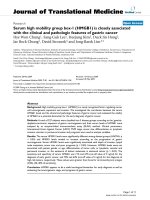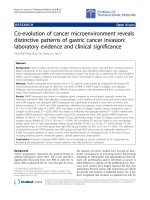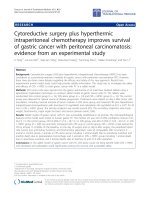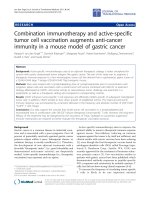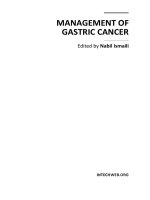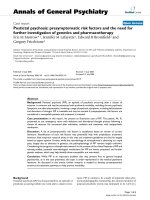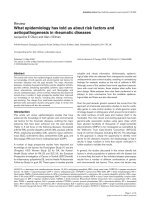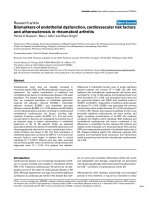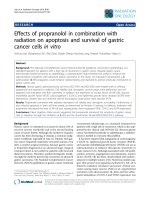Epidemiology of gastric cancer: global trends, risk factors and prevention
Bạn đang xem bản rút gọn của tài liệu. Xem và tải ngay bản đầy đủ của tài liệu tại đây (234.43 KB, 13 trang )
Review paper
Epidemiology of gastric cancer: global trends,
risk factors and prevention
Prashanth Rawla1, Adam Barsouk2
1
2
Department of Internal Medicine, SOVAH Health, Hospitalist, Martinsville, USA
Hillman Cancer Center, University of Pittsburgh, PA, USA
Gastroenterology Rev 2019; 14 (1): 26–38
DOI: />
Key words: stomach cancer, epidemiology, risk factors, prevention, gastric cancer, incidence, mortality, survival.
Address for correspondence: Prashanth Rawla, Department of Internal Medicine/Hospitalist, SOVAH Health, Martinsville, VA, 24112 USA,
phone: 732-982-7357, e-mail:
Abstract
Gastric cancer remains one of the most common and deadly cancers worldwide, especially among older males. Based on
GLOBOCAN 2018 data, stomach cancer is the 5th most common neoplasm and the 3rd most deadly cancer, with an estimated
783,000 deaths in 2018. Gastric cancer incidence and mortality are highly variable by region and highly dependent on diet and
Helicobacter pylori infection. While strides in preventing and treating H. pylori infection have decreased the overall incidence of
gastric cancer, they have also contributed to an increase in the incidence of cardia gastric cancer, a rare subtype of the neoplasm
that has grown 7-fold in the past decades. A better understanding of the etiology and risk factors of the disease can help reach
a consensus in approaching H. pylori infection. Dietary modification, smoking cessation, and exercise hold promise in preventing
gastric cancer, while genetic testing is enabling earlier diagnosis and thus greater survival.
Introduction
Although it is steadily declining in incidence, cancer
of the stomach (also known as gastric cancer) remains
one of the most common and deadly neoplasms in the
world [1]. The stomach, located in the digestive tract
between the esophagus and small intestine, secretes
enzymes and gastric acid to aid in the digestion of
food. It also secretes the intrinsic factor necessary for
the absorption of vitamin B12. The stomach is lined with
a mucous membrane composed of columnar epithelial
cells and glands. These cells are prone to inflammation,
known as gastritis, which can lead to peptic ulcers, and
ultimately, gastric cancer [2].
Gastric adenocarcinomas are primarily classified
as cardia and non-cardia based on their anatomic site.
Cancers of the gastric cardia arise in the region adjoining the esophageal-gastric junction and thus share
epidemiological characteristics with esophageal adenocarcinoma (EAC). Non-cardia cancer, also known as
distal stomach cancer, is more common and arises in
the lower portion of the stomach [3]. Histologically the
two main types of gastric cancer are the diffuse and
intestinal type [4].
Gastroenterology Review 2019; 14 (1)
According to GLOBOCAN 2018 data, gastric cancer
is the third leading cause of cancer deaths worldwide,
following only lung and colorectal cancer in overall mortality. About 1 in 12 of all oncological deaths are attributable to gastric cancer. Gastric cancer has the fifth highest incidence among cancers, with 5.7% of all new cases
attributable to the disease. Over a million new cases of
gastric cancer are diagnosed, worldwide, each year [1, 5].
Gastric cancer is also one of the most behaviorally influenced, and thus preventable, of major cancers [2].
Epidemiology
Incidence
Over one million cases of gastric cancer are diagnosed each year around the world. Stomach cancer is
the 5th most commonly diagnosed cancer in the world,
and the 7th most prevalent (Figure 1). The cumulative
risk of developing gastric cancer from birth to age 74
is 1.87% in males and 0.79% in females worldwide [1].
Gastric cancer is more prevalent in males. In developed countries, gastric cancer is 2.2 times more likely
to be diagnosed in males than females. In developing
countries, this ratio is 1.83. In 5 countries worldwide,
27
Epidemiology of gastric cancer: global trends, risk factors and prevention
The incidence of gastric cancer is highly variable by
region and culture. Incidence rates are highest in Eastern and Central Asia and Latin America (Figure 2) [6]. In
East Asia, the average incidence of gastric cancer is 32.1
per 100,000 among males and 13.2 among females. In
North America, this incidence is 5.6 per 100,000. The
rate is lowest in North and East Africa, with only 4.7
annual diagnoses per 100,000 males. The Republic of
Lung
Breast
Colorectum
Prostate
Stomach
Liver
Oesophagus
Cervix uteri
Thyroid
6 000 000
5 000 000
4 000 000
3 000 000
2 000 000
1 000 000
Bladder
0
Estimated number of cases worldwide,
both sexes, all ages
gastric cancer has the highest incidence among all cancers for males. There is no country where it is the most
diagnosed cancer in females [1].
Cancers of the stomach are more frequently diagnosed in developed nations. The average incidence rate
among high-middle Human Development Index (HDI) nations is 20 per 100,000 for males, while the average rate
among low-middle HDI nations is 6.6 per 100,000 [1].
Numbers
Incidence
Prevalence
Figure 1. Graph shows the estimated incidence and prevalence of cancer cases worldwide, both sexes, all
ages (reproduced from [5])
ASR (world) per 100 000
Not applicable
No data
Figure 2. Map shows the estimated age-standardized incidence rates (world) for stomach cancer in 2018,
both sexes, all ages (reproduced from [5])
Gastroenterology Review 2019; 14 (1)
28
Prashanth Rawla, Adam Barsouk
Mortality
Korea has the highest national incidence with almost
60 per 100,000 new cases annually for males. While
female incidence rates are lower (only 25 per 100,000
in Korea); they follow the same regional trend (Figures
3, 4) [1, 5].
Although declining in incidence, non-cardia stomach cancer continues to be diagnosed twice as often
as cardia [2].
A
Egypt
Sweden
Philippines
Canada
United Kingdom
USA
Denmark
India
Australia
France
Spain
Argentina
Germany
Italy
Brazil
Singapore
World
Russian Federation
Vietnam
Chile
China
Japan
Mongolia
Republic of Korea
2.7
3.1
2.4
4.2
3.0
4.8
2.9
5.2
2.6
5.3
2.8
5.6
2.5
6.0
2.9
6.2
2.9
6.5
2.9
7.2
4.3
9.2
4.0
9.4
4.5
9.4
4.9
9.7
5.8
10.6
7.7
10.8
7.0
8.8
10.2
10.3
12.3
USA
Egypt
Sweden
Canada
Australia
United Kingdom
The Netherlands
Philippines
France
Germany
India
Brazil
Republic of Korea
Portugal
World
Japan
Iran
Russian Federation
Chile
Vietnam
Bhutan
China
Kyrgyzstan
Mongolia
15.7
20.4
23.3
26.9
29.5
16.0
40.7
21.7
47.2
23.5
0
B
Gastric cancer was the most common cause of
cancer-related mortality globally up to the mid-1990s.
Gastric cancer accounts for 783,000 deaths each year,
making it the third most deadly cancer among males
worldwide (Figure 5). 8.3% of all cancer deaths are attributable to gastric cancer. The cumulative risk of death
10
57.8
20
30
40
Age-standarized rates (ASR) per 100 000
ASR (world) females
ASR (world) males
50
60
1.2
0
2.3
2.12.5
1.6 2.7
1.7 2.8
1.5
3.1
1.7
3.5
2.1
4.1
2.6
4.1
1.7
4.7
2.6
5.3
2.5
5.7
3.8
4.8
5.0
5.2
5.6
8.5
10.0
11.4
11.7
14.3
8.5
15.9
7.0
6.4
17.0
17.9
8.7
19.7
13.4
23.4
10.4
25.0
9.1
15.6
5
10
26.6
15
20
25
Age-standarized rates (ASR) per 100 000
ASR (world) females
ASR (world) males
36.7
30
35
Figure 3. A – Estimated age-standardized incidence rates (World) in 2018, stomach, males and females, all
ages (reproduced from [5]). B – Estimated age-standardized mortality rates (World)
in 2018, stomach, males and females, all ages (reproduced from [5])
Gastroenterology Review 2019; 14 (1)
40
29
Epidemiology of gastric cancer: global trends, risk factors and prevention
Both sexesMenWomen
Rank Country
Age-standardised
Rank Country
Age-standardised
Rank Country
Age-standardised
rate per 100,000
rate per 100,000
rate per 100,000
1 South
39.6
1South
57.8
1South
23.5
KoreaKoreaKorea
2Mongolia
33.1
2Mongolia
47.2
2Mongolia
21.7
3Japan
27.5
3Japan
40.7
3Japan
16
4China
20.7
4China
29.5
4Guatemala
14.2
5Bhutan
19.4
5Kyrgyzstan
29.3
5Bhutan
13.5
6Kyrgyzstan
18.6
6Chile
26.9
6Peru
13.4
7Chile
17.8
7Belarus
25.1
7Mali
12.8
8Belarus
16.5
7Cape Verde
25.1
8China
12.3
9Peru
16.1
9Kazakhstan
24.7
9Ecuador
12.2
10Vietnam
15.9
10Bhutan
24.2
10Tajikistan
11.6
Estimated age-standardized mortality
rates (world) in 2018, worldwide,
males, all ages
Figure 4. Table shows the estimated age-standardized incidence rates per 100,000 for stomach cancer in
2018, all ages, in both sexes, men and women (reproduced and modified from [5])
Lung
Liver
Stomach
Colorectum
Oesophagus
Prostate
Pancreas
Leukaemia
Non-Hodgkin lymphoma
Brain, nervous system
Estimated age-standardized mortality
rates (world) in 2018, worldwide,
females, all ages
0
4
8
12
16
20
ASR (world) per 100 000
24
28
Breast
Lung
Colorectum
Cervix uteri
Stomach
Liver
Ovary
Pancreas
Oesophagus
Leukaemia
0
2
4
6
8
10
ASR (world) per 100 000
12
Figure 5. Graph shows the estimated age-standardized mortality rates (world) in 2018, worldwide, males
and females, all ages (reproduced from [5])
from gastric cancer, from birth to age 74, is 1.36% for
males and 0.57% for females [1].
Mortality from gastric cancer is higher among males.
Mortality rates are high in eastern and central Asia and
Latin America, the same regions with high incidence.
Due to historically low survival rates and few treatment
options, especially in developing nations, reducing incidence seems to be the key to reducing mortality [6].
For males, gastric cancer is the leading oncological
cause of death in 10 nations worldwide, specifically,
Gastroenterology Review 2019; 14 (1)
30
Prashanth Rawla, Adam Barsouk
ASR (world) per 100 000
Not applicable
No data
Figure 6. Map shows the estimated age-standardized mortality rates (world) for stomach cancer in 2018,
both sexes, all ages (reproduced from [5])
eastern and central Asian nations such as Iran, Kyrgyzstan, and Turkmenistan. For females, it is the leading
oncological cause of death in 4 nations (Figure 6) [1].
Trends
The incidence of gastric cancer has steadily declined
worldwide over the past 50 years. These declines preceded the successful reduction of H. pylori infection, and
are likely attributable to changes in food preservation,
such as less pickling of vegetables, and less smoking and
processing of meat. The decline has also been elicited by
the greater availability of fresh fruits and vegetables [6].
The second major factor in gastric cancer decline
has been the success in preventing and treating H. pylori infections in much of the developing world. As many
as 90% of cases of non-cardia gastric cancer are attributable to H. pylori, which explains why the incidence
of that subtype of gastric cancer has declined in step
with declining infection rates [6]. Meanwhile, during
that same period, cardia-subtype gastric cancers have
increased 7-fold, especially in the developed world [2].
Non-cardia cancer incidence rates are falling in East
Asia due to a reduction of H. pylori infections. However,
Latin America is not witnessing a similarly effective campaign against H. pylori, and gastric cancer incidence is
likely to remain high there for the foreseeable future [6].
Gastric cancer survival rates have also steadily improved over the past 40 years thanks to earlier detection and better treatment options [6].
Gastroenterology Review 2019; 14 (1)
Survival
The 5-year survival rate for gastric cancer is 31% in
the United States. Average survival rates reflect the fact
that most cases diagnosed are already metastatic. The
5-year survival rate for pre-metastatic diagnosis is 67%.
Survival is highly variable based on stage during surgical intervention. The 5-year survival rates for stage IA
and IB tumors treated with surgery are 94% and 88%,
respectively. On the other hand, stage IIIC tumors treated with surgery had a 5-year survival rate of 18% [7].
Asian patients in the United States tend to have
a better prognosis than Caucasians. Asians have a 12%
higher 5-year survival rate. They are diagnosed earlier,
have more lymph nodes examined, and more of their
lymph nodes test positive [8].
In the United Kingdom, the 5-year survival rate is
19%, and the 10-year survival rate is 15%. Nevertheless,
these rates represent a marked improvement in gastric
cancer treatment. For the 1971–1972 period in the UK,
the 5-year survival rate was 5.3%, and the 10-year survival rate was 4.1% (Figure 7) [9].
The average 5-year survival rate in Europe is 26%,
higher than in the UK but lower than that of the US. The
highest survival rate in Europe belongs to Iceland, which
reports a 42% 5-year survival rate among women [9].
Etiology
Ninety-five percent of cancers of the stomach are
adenocarcinomas, followed by primary gastric lympho-
31
Epidemiology of gastric cancer: global trends, risk factors and prevention
Risk factors
Genetics
Inherited mutations of certain genes, such as the
GSTM1-null phenotype or CDH1 gene, have been found
to increase the risk of stomach cancer. Loss of one of
the copies of the CDH1 gene results in hereditary diffuse gastric cancer (HDGC), an autosomal dominantly
inherited condition wherein malignant cells promulgate
underneath the stomach lining and consequently metastasize. HDGC and loss of CDH1 are also associated
with lobular breast cancer, prostate cancer, and colorectal cancer [12].
IL-17 and IL-10, polymorphisms of the interleukin
genes especially common in Asian populations, are also
associated with an elevated risk of the neoplasm. Lynch
syndrome is another common hereditary disorder that
increases the risk of gastric cancer [2, 12].
Gastric adenocarcinoma and proximal polyposis
of the stomach (GAPPS) is a cancer-predisposing syndrome inherited in an autosomal dominant pattern. It
has been mapped to the gene 5q22, which results in
the loss of the WT allele in fundic gland polyps [12, 13].
Point mutations in the APC promoter appear to be drivers of the disorder.
Likewise, familial adenomatous polyposis (FAP), the
most common form of familial intestinal gastric cancer,
is an autosomal-dominant inherited predisposition to adenomatous polyps caused by germline mutations in the
APC gene. Nevertheless, the lifetime risk of developing
gastric cancer among FAP patients is less than 1%, indi-
100
90
80
70
60
50
40
30
20
10
0
Net survival (%)
ma. These adenocarcinomas are divided into cardia and
non-cardia cancer based on their anatomical site.
Non-cardia cancers are brought about by chronic
gastritis, inflammation of the stomach lining which
can be caused by a variety of environmental factors.
The pathogenesis of cardia cancer remains unclear,
although two distinct etiologies have been proposed:
one is associated with gastroesophageal reflux disease
(GERD) and resembles esophageal adenocarcinoma,
and the other is associated with H. pylori atrophic gastritis and resembles non-cardia cancer [3].
These cancers are further histologically divided into either the intestinal (well-differentiated) or the diffuse (undifferentiated) category. The intestinal type is the more
common, with the highest incidence among older males,
but also carries a better prognosis [2], whereas the diffuse
type affects younger people and frequently females [10].
Risk factors associated exclusively with cardia gastric cancer include obesity and GERD, while H. pylori infection, low socioeconomic status, and dietary factors
are risk factors that are exclusive for non-cardia gastric
cancer [11].
1971– 1980– 1990–2000–2005– 2010–
1972 1981 199120012006 2011
Period of diagnosis
Men
Women
Adults
Figure 7. Bar chart of stomach cancer, age-standardized 5-year net survival, adults (aged 15–99),
England and Wales, 1971–2011 (reproduced
from reference [9])
cating that it requires an environmental component in
order to transform the polyps into adenocarcinomas [12].
All these genetic variants have been found to contribute to 1–3% of cases [2]. A strong environmental
component is believed to be the greatest factor in the
regional variability of gastric cancer incidence [6].
Helicobacter pylori
The main risk factor for gastric cancer is the bacterium H. pylori. In 2005, Australian researchers Barry Marshall and Robin Warren were awarded the Nobel Prize
in Medicine for the discovery of the bacterium H. pylori.
Prior to their finding, lifestyle and stress were hypothesized to be the major risk factors in peptic ulcer disease.
In 1985, Marshall deliberately infected himself with the
bacterium to demonstrate that it caused acute gastritis.
Thanks to their work, we now know that up to 80% of
gastric ulcers are caused by H. pylori [14].
Gastritis brought about by the bacterium also elicits the majority of gastric cancers. 90% of cases of the
non-cardia subtype are associated with the bacterium
[3]. In fact, H. pylori has been found to increase the
odds ratio of stomach cancer by 5.9× within ten years
of infection. IL-10 and IL-17, the polymorphisms associated with gastric cancer, have been shown to interact
with H. pylori infection [2].
Meanwhile, recent studies indicate that the cardia
subtype has two distinct etiologies: one resembling
esophageal adenocarcinoma (EAC), most commonly
H. pylori negative, and the other resembling non-cardia
cancer in etiology [3].
Genomic sequencing and post-genomic analyses of
the H. pylori bacterium have revealed a long history of
coevolution with the human host. Many have specu-
Gastroenterology Review 2019; 14 (1)
32
Prashanth Rawla, Adam Barsouk
lated that humans once had a symbiotic relationship
with the bacterium and that the recent campaign for
eradicating the pathogen may be misbegotten. Many
nations, such as India, that have persistently high
H. pylori infection rates do not suffer from high gastric
cancer incidence. The interaction between H. pylori and
genetics and diet may explain these discrepancies [14].
While H. pylori infection increases the risk of gastric
cancer, it has also been shown to protect against gastro-esophageal reflux and esophageal adenocarcinoma.
While the bacterium promotes corpus (non-cardia) gastritis, it is known to reduce acid secretion in the proximal (cardia) portion of the stomach, thus decreasing
gastritis in the esophagus and cardia. As it reduces the
risk of esophageal inflammation, H. pylori has also been
shown to protect against cardia gastric cancer [3, 9].
Furthermore, H. pylori infection has been associated
with lower risks of asthma and obesity [9].
Therefore, it may be that success in eradicating
H. pylori, which has decreased the incidence of non-cardia gastric cancer in the developed world, has actually
increased the incidence of the cardia subtype. The United States and the United Kingdom have the highest
proportion of cardia relative to non-cardia stomach cancer, possibly due to the complete absence of the H. pylori bacterium [15]. A recent study in Hong Kong in 63,397
subjects has shown that long-term use of proton pump
inhibitors (PPIs) was associated with a 2.4-fold increase
in gastric cancer risk in H. pylori-infected subjects who
had received eradication therapy. The risk of gastric
cancer increases in a dose- and duration-dependent
manner with the use of PPIs [16].
Advocates of the “hygiene hypothesis” further point
out that exposure to a bacteria-free environment early
in life, as brought about by antibiotics during the treatment of H. pylori, increases the risk of certain autoimmune disorders later in life, while also enabling the
spread of antibiotic resistance [17].
Gastric ulcer
Helicobacter pylori is the main risk factor in the association between gastric ulcer and gastric cancer [18,
19]. In a large cohort of 57,936 Swedish patients it was
found that the risk of gastric cancer was almost twice
the expected rate among patients with gastric ulcers
and there was a 40% reduction in risk of gastric cancer
among patients with duodenal ulcers [18]. Helicobacter
pylori eradication in gastric ulcer patients may reduce
the risk of developing gastric cancer [20].
Gastroesophageal reflux disease
Several studies have reported significant associations between GERD and cardia gastric cancer [21, 22].
Gastroenterology Review 2019; 14 (1)
Cardia gastric cancer was positively associated with
both severe gastric atrophy and with frequent GERD
symptoms [23]. Multiple distinct pathways of tumorigenesis exist at the esophagogastric junction, including one in which tumors arise from dysplastic intestinal
metaplasia, and one potentially involving dysplasia of
the cardiac-type mucosa [24]. The incidence of reflux-related cardia cancer has steadily increased when compared to H. pylori-related cardia cancer. Incidence rate
trends in reflux-related cardia cancer and esophageal
adenocarcinoma are very similar, suggesting that these
two cancers share a similar etiology and pathophysiological process [25].
Smoking
Tobacco use has been shown to increase the risk
of cardia gastric cancer. Tobacco has been implicated
in the recent rise of cardia gastric cancer in developed
nations. It is estimated that 11% of global stomach cancers, and 17% of cases in Europe, are attributable to
smoking [2]. A meta-analysis of 42 studies estimated
that in smokers the risk of gastric cancer was increased
approximately 1.53-fold and was higher in men than
in women [26]. A recent study has shown that hookah
and opium use are risk factors for gastric cancer and
precancerous lesions [27].
Alcohol
Alcohol use has been shown to increase the risk
of gastric cancer, but the effect of the amount of alcohol consumed and gastric cancer risk has been
controversial. Based on a meta-analysis of 10 studies,
moderate alcohol consumption was shown to increase
gastric cancer risk by 39%, while heavy consumption
further worsened the odds. Another meta-analysis of
44 case-control and 15 cohort studies showed a lack
of association between moderate alcohol drinking and
gastric cancer risk. However, a positive association of
gastric cancer with heavy alcohol drinking was found
[28]. Alcohol is known to irritate and erode the stomach lining, resulting in gastritis, a precursor for stomach
cancer [29, 30].
Chemical exposure
Occupational exposure to dust, high-temperature
particulates, and metals such as chromium VI has also
been implicated in non-cardia stomach cancer. Occupations as varied as wood processing, food machine operation, rubber manufacturing, coal mining, and metal
processing have been found to carry a greater risk of
the neoplasm [2]. A recent meta-analysis of 40 mortality cohort studies showed that asbestos is associated
33
Epidemiology of gastric cancer: global trends, risk factors and prevention
with a moderately increased risk of stomach cancer
[31]. A recent meta-analysis of 13 observational studies
showed that occupational talc exposure is associated
with an increased risk of stomach cancer [32]. A significant relationship has been found between occupational
crystalline silica exposure and gastric cancer [33].
Diet
Ingestion of salt has been shown to increase gastritis and the carcinogenic effects of known gastric carcinogens such as N-methyl-N-nitro-N-nitrosoguanidine
(MNNG). Salt is known to erode the mucosal barrier of
the stomach, thereby leading to inflammation. Cultures
whose diets are rich in salt and pickled foods, such as
the Japanese, exhibit higher rates of gastric cancer. Japanese immigrants to the United States who assimilated
and adopted Western foods exhibited a substantially
lower rate of gastric cancer relative to those who did
not assimilate their diet [29].
Preserved meats are rich in N-nitroso compounds,
which can elicit a similar effect in the body. Grain-fed
red meat is especially rich in saturated fats and low in
protective fats such as omega-3, which contributes to
its inflammatory processes and thus increases gastric
cancer risk [29].
A meta-analysis of nine prospective studies demonstrated that coffee consumption was not associated
with overall gastric cancer risk. However, subgroup analysis showed that coffee consumption might be a risk
factor for gastric cardia cancer [34].
Meanwhile, fruits and vegetables are rich in carotenoids, folate, phytochemicals and vitamin C, which help
modulate xenobiotic metabolizing enzymes during digestion. Fruits and vegetables also contain numerous antioxidants that prevent against metabolic damage. Vitamin C,
also known as ascorbic acid, is a powerful antioxidant
found in high concentrations in citrus fruit. Case-control
studies found that a higher intake of fruits and vegetables was associated with a 37% lower risk of gastric cancer. Non-dietary antioxidant sources such as green tea,
vitamin A, C and E supplements, and selenium have seen
mixed results in preventing gastric cancer [29].
Obesity
A statistical meta-analysis from around the world
found that those with an excess body mass index (over
25 kg/m2) have a 1.13 odds ratio of developing cancer.
The strength of the association increased with increasing BMI. Obesity was an especially strong predisposing
factor for males and non-Asians. Obesity may induce
inflammation of the stomach lining via tumor necrosis factor-α (TNF-α), interleukin-6 (IL-6), and monocyte
chemoattractant protein-1 (MCP-1). Those with a diet of
heavily inflammatory foods, such as a diet high in meat
and low in fruits and vegetables, also have a higher risk
of being obese [29, 35].
Pernicious anemia
Studies have found that those with pernicious anemia have a 6.9% chance of developing gastric cancer,
particularly non-cardia cancer, which is more than five
times the risk of the general population. The link between the disorders remains unknown. Chronic gastritis, as caused by H. pylori infection, may lead to the
long-term use of PPIs, which decrease B12 absorption
and thus cause pernicious anemia. Those with pernicious anemia and gastric cancer also share many risk
factors, such as alcohol consumption and smoking [36].
Gastric surgery
There is an increased risk for gastric cancer after
gastric surgery [37–39]. Risk depends on the reason for
the initial surgery and type of surgery [39, 40]. The Billroth II procedure (gastrojejunostomy) carries a higher
risk when compared to the Billroth I procedure (gastroduodenostomy) [39, 40]. The interval between initial
gastric surgery for benign disease and the development
of gastric stump carcinoma is approximately 30 years
or more, compared to 12 years if surgery was done for
prior gastric cancer [39, 41].
Radiation
Follow-up of survivors of the Hiroshima and Nagasaki atomic bombs has established radiation as a risk
factor for gastric cancer [42]. Childhood cancer survivors are at 4.6 times increased risk for gastrointestinal
cancers compared to the general population. The risk
was highest in cancer survivors who had abdominal
radiation (standardized incidence ratio (SIR) 11.2, 95%
confidence interval (CI): 7.6–16.4). However, survivors
not exposed to radiation also still had a significantly
increased risk (SIR: 2.4, 95% CI: 1.4–3.9) [43]. A study
on Hodgkin’s lymphoma patients who had received
subdiaphragmatic radiotherapy showed dose-dependent increased risk of stomach cancer. The risk was
77 times higher in patients who received both radiation
and high dose procarbazine [44]. A recent study has
shown that testicular cancer (TC) patients are at 1.45%
risk for stomach cancer after 30 years of TC diagnosis.
Risk increases to 5.9 times in TC survivors who have
received radiotherapy [45].
Epstein-Barr virus (EBV)
Approximately 5–10% of gastric carcinomas are associated with EBV [46]. A meta-analysis of 70 studies showed
Gastroenterology Review 2019; 14 (1)
Rate per 100,000
34
Prashanth Rawla, Adam Barsouk
18
16
14
12
10
8
6
4
2
0
Sex
2000 20022004 2006 2008 2010 2012 2014
Diagnosis [years]
All races (includes Hispanic)
American Indian/Alaska native (includes Hispanic)
Asian/Pacific Islander (includes Hispanic)
Black (includes Hispanic)
Hispanic (any race)
Non-Hispanic White
White (includes Hispanic)
Figure 8. Stomach cancer, recent trends in SEER
incidence rates, 2000–2015 by race/ethnicity
(reproduced from http:// seer.cancer.gov/ [60])
the EBV associated gastric cancer is two times more common in males than in females. It was also found that EBV
associated gastric cancer is more common in the gastric
cardia or postsurgical gastric stump area [47]. Recent studies have suggested that EBV and coinfection with H. pylori increase the occurrence of gastric carcinoma [48]. The
exact role of EBV in gastric carcinoma is still unclear [49].
Socioeconomic status (SES)
An increased risk of gastric cancer was associated
with low SES [50]. Higher SES has been reported to be
associated with a lower risk of occurrence of gastric
cancer. Lower SES was associated with lower survival rates [51]. Higher education was closely associated
with a reduced risk of gastric cancer, and this effect was
more pronounced for cancer of the cardia when compared to non-cardia gastric cancer [52]. Higher rates
of H. pylori infection or lower access to fresh food, fruits
and vegetables may be responsible for the association
of low SES and a higher risk of gastric cancer [11].
Blood group
The relation between cancer of the stomach and
blood group A was first reported in 1953, by Aird et al.
[53]. Numerous studies have shown that blood group A is
associated with a higher risk of gastric cancer. An increase
in pernicious anemia was also seen in this group [54,
55]. A large prospective population-based study in Scandinavia confirmed that blood type A is associated with
a higher risk of gastric cancer and that blood group O
is associated with a higher risk of peptic ulcers [55].
Gastroenterology Review 2019; 14 (1)
Gastric cancer rates have been considerably lower
in females than males [1, 56]. A possible explanation
might be that the protective effect of estrogen may
lower the risk of gastric cancer in women. Other causes
such as differences in diet and occupational exposure
may contribute to increased gastric cancer incidence in
males [57]. Gastric cancer risk is lowered by delayed
menopause and increased fertility. Increased risk may
be seen with anti-estrogen drugs, for example tamoxifen [58, 59]. After menopause the incidence of gastric
cancer in women has a similar pattern to that in men,
but with a 10- to 15-year lag period [57].
Race/ethnicity
Data from the 2000 to 2015 Surveillance, Epidemiology, and End Results (SEER) registries in the United
States show that the incidence of gastric cancer (rates
per 100,000/year for both sexes in the year 2000 vs.
the year 2015) among whites (7.3 vs. 6.2) is significantly lower than in Asians/Pacific Islanders (16.3 vs.
9.4), African Americans (13.2 vs. 9.8), American Indian/Alaska Native (11.7 vs. 9.5) and Hispanics (12.6 vs.
10.0) (Figure 8) [60]. A systematic review of 74 studies
has shown that incidence and mortality rates from
stomach cancer have decreased in the last four decades in most parts of the world, but rates have increased for some indigenous population groups. High
rates of stomach cancer were observed in Indigenous
Siberians, Mapuche in South America, Inuit in Arctic
regions of Greenland, Canada and Alaska and Maoris
in New Zealand [61].
Screening
There are significant regional differences in the
incidence of gastric cancer. Japan and South Korea
are countries which have national gastric cancer
screening programs. Other countries where universal
or population-based screening has been implemented include Venezuela and Chile. Screening for gastric
cancer generally involves contrast radiography and
endoscopy [62]. Other non-invasive methods used
are serum pepsinogen levels, H. pylori serology, and
serum trefoil factor 3, although their use has been
controversial. Further studies are needed to define
the role of these non-invasive methods of screening
for gastric cancer.
Endoscopy allows direct visual examination of the
gastric mucosa, and it allows for biopsy and histologic
evaluation. In Japan, gastric cancer screening annually
for all residents aged 40 years and older with upper
gastrointestinal (UGI) series was initiated in 1983,
35
Epidemiology of gastric cancer: global trends, risk factors and prevention
and in 2015 the Japanese guidelines were updated
to allow screening with either endoscopy or UGI series [63]. Similarly, in Korea, endoscopy or UGI series
is recommended every two years for individuals aged
40 years and older [62]. The optimal interval for gastric
cancer screening has not been established in randomized trials.
Antioxidant supplements (such as vitamins A, C, and
E and the mineral selenium) and green tea have been
suggested to reduce the risk of gastric cancer. However,
studies have found that those with adequate nutrition
do not further benefit from these antioxidant supplements or green tea [29, 66].
Prevention
Regular Aspirin, or other non-steroidal anti-inflammatory drugs (NSAIDs) such as naproxen or ibuprofen,
have been shown to lower the risk of stomach cancer,
as well as colon cancer. In a nationwide retrospective
cohort study in Taiwan on 52,161 patients, regular
NSAID use was found to be an independent protective
factor for gastric cancer development (hazard ratio
(HR) 0.79 for each incremental year; p < 0.001), especially in H. pylori-associated patients (HR = 0.52 for
each incremental year; p < 0.001) [67]. In another meta-analysis of 24 studies by Huang et al. it was found
that the use of NSAIDs is inversely associated with GC
risk (risk ratio = 0.78, 96% CI: 0.72–0.85), especially
for non-cardia GC risk [68]. However, NSAIDs also increase the risk of internal bleeding. Studies have not
yet determined whether the benefits outweigh the
costs for the general population. Therefore, NSAIDs
are not recommended for the prevention of stomach
cancer, though those taking them for chronic pain or
as a blood thinner may benefit from a lowered risk of
the neoplasm [69].
Those with a family history of stomach cancer, or
who have personally had invasive lobular breast cancer before age 50, are recommended to undergo genetic testing for abnormal changes in the CDH1 gene,
which greatly increase the risk of gastric cancer [70].
Physicians may recommend that those testing positive
for this should have their stomach prophylactically removed. Lynch syndrome is another hereditary disease
associated with gastric cancer [71].
Helicobacter pylori testing and treatment
Despite the controversy, the eradication of H. pylori
in the developing world remains a primary goal in the
fight against gastric cancer due to its strong association with non-cardia gastric cancer. Helicobacter pylori can be detected serologically, for example with an
ELISA or HelicoTest or via the benchmark urea breath
test (UBT). An endoscopy followed by a plate culture
is a more invasive option to test for H. pylori infection
[64]. Whether treatment is necessary for those with
chronic, largely asymptomatic infections remains controversial [15].
Lifestyle modifications
Many factors other than H. pylori have been implicated in the incidence of gastric cancer. Daily consumption of three or more servings of alcohol and high-salt
foods significantly increase the risk of gastric cancer.
Processed meat was found to significantly increase the
risk of non-cardia gastric cancer, while obesity was associated with a higher risk of stomach cardia cancer [2].
Other findings suggest that fruits and vegetables,
especially citrus fruit such as oranges, lemons, and
grapefruit, help to decrease the risk of the disease [65].
It is important to discuss with one’s doctor before adding grapefruit to one’s diet, as it may interact with other
medications and exacerbate certain medical conditions
[29, 66].
Diet modification is the most established form of
prevention of gastric cancer. A wholesome diet rich
in fruits, vegetables, whole grains, and low in alcohol,
pickled foods, and processed, smoked or salted meats
(especially red meat), not only lowers the risk of stomach inflammation and gastric cancer [29], but also helps
prevent high blood pressure and obesity, thus decreasing one’s risk for a wide array of chronic diseases [66].
Exercise is also an essential component of any
weight loss program. Both are aerobic, and strength
exercises are recommended to build muscle mass and
lose and keep off weight [66].
Tobacco use has also been shown to increase the
risk of cardia gastric cancer. Smoking is also responsible
for one-third of cancer deaths in the United States [2].
Therapeutics and genetic testing
Conclusions
Significant global strides have been made in the
global prevention and treatment of gastric cancer. Nevertheless, the neoplasm remains the 5th most commonly
diagnosed, and the 3rd most deadly. While H. pylori infection is the most established risk factor, eradicating
the bacterium may actually increase the risk of a subtype of the disease. Instead, more focus is being placed
on the interaction between diet, genetics, and H. pylori.
Diet and lifestyle modification have been revealed to be
the most effective means of preventing gastric cancer,
especially in the developed world, while advances in genetic testing are enabling earlier detection and better
survival.
Gastroenterology Review 2019; 14 (1)
36
Prashanth Rawla, Adam Barsouk
Conflict of interest
The authors declare no conflict of interest.
References
1. Bray F, Ferlay J, Soerjomataram I, et al. Global cancer statistics 2018: GLOBOCAN estimates of incidence and mortality
worldwide for 36 cancers in 185 countries. CA Cancer J Clin
2018; 68: 394-424.
2. World Cancer Research Fund/American Institute for Cancer
Research (WCRF/AICR). Continuous Update Project Report:
Diet, Nutrition, Physical Activity and Stomach Cancer 2016.
Revised 2018. London: World Cancer Research Fund International; 2018.
3. Mukaisho K, Nakayama T, Hagiwara T, et al. Two distinct etiologies of gastric cardia adenocarcinoma: interactions among
pH, Helicobacter pylori, and bile acids. Front Microbiol 2015;
6: 412.
4. Lauren P. The two histological main types of gastric carcinoma:
diffuse and so-called intestinal-type carcinoma. An attempt
at a histo-clinical classification. Acta Pathol Microbiol Scand
1965; 64: 31-49.
5. Ferlay J, Ervik M, Lam F, et al. Global Cancer Observatory: Cancer Today. Lyon, France: International Agency for Research on
Cancer. Available from: Accessed 09
October 2018. In. 2018.
6. Balakrishnan M, George R, Sharma A, Graham DY. Changing
trends in stomach cancer throughout the world. Curr Gastroenterol Rep 2017; 19: 36.
7. Howlader NA, Krapcho M, Miller D, et al. SEER Cancer Statistics
Review, 1975-2014, National Cancer Institute. Bethesda, MD,
based on November
2016 SEER data submission, posted to the SEER web site, April
2017. 2017.
8. Wang J, Sun Y, Bertagnolli MM. Comparison of gastric cancer
survival between Caucasian and Asian patients treated in the
United States: results from the Surveillance Epidemiology
and End Results (SEER) database. Ann Surg Oncol 2015; 22:
2965-71.
9. Cancer Research UK. />health-professional/cancer-statistics/statistics-by-cancer-type/
stomach-cancer/survival#heading-Two. Accessed October 3,
2018. In.
10.Chon HJ, Hyung WJ, Kim C, et al. Differential prognostic implications of gastric signet ring cell carcinoma: stage adjusted
analysis from a single high-volume center in Asia. Ann Surg
2017; 265: 946-53.
11.Karimi P, Islami F, Anandasabapathy S, et al. Gastric cancer: descriptive epidemiology, risk factors, screening, and prevention.
Cancer Epidemiol Biomarkers Prev 2014; 23: 700-13.
12.Boland CR, Yurgelun MB. Historical perspective on familial gastric cancer. Cell Mol Gastroenterol Hepatol 2017; 3: 192-200.
13.Li J, Woods SL, Healey S, et al. Point mutations in exon 1B of
APC reveal gastric adenocarcinoma and proximal polyposis of
the stomach as a familial adenomatous polyposis variant. Am
J Hum Genet 2016; 98: 830-42.
14.Ahmed N. 23 years of the discovery of Helicobacter pylori: is
the debate over? Ann Clin Microbiol Antimicrob 2005; 4: 17.
Gastroenterology Review 2019; 14 (1)
15.Graham DY. Helicobacter pylori update: gastric cancer, reliable
therapy, and possible benefits. Gastroenterology 2015; 148:
719-31.
16.Peng YC, Huang LR, Lin CL, et al. Association between proton
pump inhibitors use and risk of gastric cancer in patients with
GERD. Gut 2018. doi: 10.1136/gutjnl-2018-316057.
17.Okada H, Kuhn C, Feillet H, Bach JF. The ‘hygiene hypothesis’
for autoimmune and allergic diseases: an update. Clin Exp Immunol 2010; 160: 1-9.
18.Hansson LE, Nyren O, Hsing AW, et al. The risk of stomach
cancer in patients with gastric or duodenal ulcer disease.
N Engl J Med 1996; 335: 242-9.
19.Molloy RM, Sonnenberg A. Relation between gastric cancer
and previous peptic ulcer disease. Gut 1997; 40: 247-52.
20.Take S, Mizuno M, Ishiki K, et al. The effect of eradicating
Helicobacter pylori on the development of gastric cancer in
patients with peptic ulcer disease. Am J Gastroenterol 2005;
100: 1037-42.
21.Wu AH, Tseng CC, Bernstein L. Hiatal hernia, reflux symptoms,
body size, and risk of esophageal and gastric adenocarcinoma.
Cancer 2003; 98: 940-8.
22.Ye W, Chow WH, Lagergren J, et al. Risk of adenocarcinomas
of the esophagus and gastric cardia in patients with gastroesophageal reflux diseases and after antireflux surgery. Gastroenterology 2001; 121: 1286-93.
23.Derakhshan MH, Malekzadeh R, Watabe H, et al. Combination
of gastric atrophy, reflux symptoms and histological subtype
indicates two distinct aetiologies of gastric cardia cancer. Gut
2008; 57: 298-305.
24.Demicco EG, Farris AB 3 rd, Baba Y, et al. The dichotomy in
carcinogenesis of the distal esophagus and esophagogastric
junction: intestinal-type vs. cardiac-type mucosa-associated
adenocarcinoma. Mod Pathol 2011; 24: 1177-90.
25.Abrams JA, Gonsalves L, Neugut AI. Diverging trends in the incidence of reflux-related and Helicobacter pylori-related gastric
cardia cancer. J Clin Gastroenterol 2013; 47: 322-7.
26.Ladeiras-Lopes R, Pereira AK, Nogueira A, et al. Smoking and
gastric cancer: systematic review and meta-analysis of cohort
studies. Cancer Causes Control 2008; 19: 689-701.
27.Sadjadi A, Derakhshan MH, Yazdanbod A, et al. Neglected role
of hookah and opium in gastric carcinogenesis: a cohort study
on risk factors and attributable fractions. Int J Cancer 2014;
134: 181-8.
28.Tramacere I, Negri E, Pelucchi C, et al. A meta-analysis on alcohol drinking and gastric cancer risk. Ann Oncol 2012; 23:
28-36.
29.Tsugane S, Sasazuki S. Diet and the risk of gastric cancer: review of epidemiological evidence. Gastric Cancer 2007; 10:
75-83.
30.Ma K, Baloch Z, He TT, Xia X. Alcohol consumption and gastric
cancer risk: a meta-analysis. Med Sci Monit 2017; 23: 238-46.
31.Fortunato L, Rushton L. Stomach cancer and occupational exposure to asbestos: a meta-analysis of occupational cohort
studies. Br J Cancer 2015; 112: 1805-15.
32.Chang CJ, Tu YK, Chen PC, Yang HY. Talc exposure and risk
of stomach cancer: systematic review and meta-analysis of
occupational cohort studies. J Formos Med Assoc 2018. doi:
10.1016/j.jfma.2018.07.015.
Epidemiology of gastric cancer: global trends, risk factors and prevention
33.Lee W, Ahn YS, Lee S, et al. Occupational exposure to crystalline silica and gastric cancer: a systematic review and meta-analysis. Occup Environ Med 2016; 73: 794-801.
34.Liu H, Hua Y, Zheng X, et al. Effect of coffee consumption
on the risk of gastric cancer: a systematic review and metaanalysis of prospective cohort studies. PLoS One 2015; 10:
e0128501.
35.Lin XJ, Wang CP, Liu XD, et al. Body mass index and risk of gastric cancer: a meta-analysis. Jpn J Clin Oncol 2014; 44: 783-91.
36.Kuipers EJ. Pernicious anemia, atrophic gastritis, and the risk of
cancer. Clin Gastroenterol Hepatol 2015; 13: 2290-2.
37.Ahn HS, Kim JW, Yoo MW, et al. Clinicopathological features
and surgical outcomes of patients with remnant gastric cancer
after a distal gastrectomy. Ann Surg Oncol 2008; 15: 1632-9.
38.Komatsu S, Ichikawa D, Okamoto K, et al. Progression of remnant gastric cancer is associated with duration of follow-up
following distal gastrectomy. World J Gastroenterol 2012; 18:
2832-6.
39.Takeno S, Hashimoto T, Maki K, et al. Gastric cancer arising
from the remnant stomach after distal gastrectomy: a review.
World J Gastroenterol 2014; 20: 13734-40.
40.Tersmette AC, Offerhaus GJ, Tersmette KW, et al. Meta-analysis of the risk of gastric stump cancer: detection of high
risk patient subsets for stomach cancer after remote partial
gastrectomy for benign conditions. Cancer Res 1990; 50:
6486-9.
41.Lagergren J, Lindam A, Mason RM. Gastric stump cancer after distal gastrectomy for benign gastric ulcer in a population-based study. Int J Cancer 2012; 131: E1048-52.
42.Preston DL, Ron E, Tokuoka S, et al. Solid cancer incidence in
atomic bomb survivors: 1958-1998. Radiat Res 2007; 168: 1-64.
43.Henderson TO, Oeffinger KC, Whitton J, et al. Secondary gastrointestinal cancer in childhood cancer survivors: a cohort study.
Ann Intern Med 2012; 156: 757-66.
44.Morton LM, Dores GM, Curtis RE, et al. Stomach cancer risk
after treatment for Hodgkin lymphoma. J Clin Oncol 2013; 31:
3369-77.
45.Hauptmann M, Fossa SD, Stovall M, et al. Increased stomach
cancer risk following radiotherapy for testicular cancer. Br
J Cancer 2015; 112: 44-51.
46.Boysen T, Mohammadi M, Melbye M, et al. EBV-associated
gastric carcinoma in high- and low-incidence areas for nasopharyngeal carcinoma. Br J Cancer 2009; 101: 530-3.
47.Murphy G, Pfeiffer R, Camargo MC, Rabkin CS. Meta-analysis
shows that prevalence of Epstein-Barr virus-positive gastric
cancer differs based on sex and anatomic location. Gastroenterology 2009; 137: 824-33.
48.Singh S, Jha HC. Status of Epstein-Barr virus coinfection with
Helicobacter pylori in gastric cancer. J Oncol 2017; 2017:
3456264.
49.Cho J, Kang MS, Kim KM. Epstein-Barr virus-associated gastric
carcinoma and specific features of the accompanying immune
response. J Gastric Cancer 2016; 16: 1-7.
50.Uthman OA, Jadidi E, Moradi T. Socioeconomic position and incidence of gastric cancer: a systematic review and meta-analysis. J Epidemiol Community Health 2013; 67: 854-60.
51.Sun F, Sun H, Mo X, et al. Increased survival rates in gastric
cancer, with a narrowing gender gap and widening socioeco-
37
nomic status gap: a period analysis from 1984 to 2013. J Gastroenterol Hepatol 2018; 33: 837-46.
52.Nagel G, Linseisen J, Boshuizen HC, et al. Socioeconomic position and the risk of gastric and oesophageal cancer in the
European Prospective Investigation into Cancer and Nutrition
(EPIC-EURGAST). Int J Epidemiol 2007; 36: 66-76.
53.Aird I, Bentall HH, Roberts JA. A relationship between cancer of stomach and the ABO blood groups. Br Med J 1953; 1:
799-801.
54.Hoskins LC, Loux HA, Britten A, Zamcheck N. Distribution of
ABO blood groups in patients with pernicious anemia, gastric
carcinoma and gastric carcinoma associated with pernicious
anemia. N Engl J Med 1965; 273: 633-7.
55.Edgren G, Hjalgrim H, Rostgaard K, et al. Risk of gastric cancer
and peptic ulcers in relation to ABO blood type: a cohort study.
Am J Epidemiol 2010; 172: 1280-5.
56.Freedman ND, Chow WH, Gao YT, et al. Menstrual and reproductive factors and gastric cancer risk in a large prospective
study of women. Gut 2007; 56: 1671-7.
57.Camargo MC, Goto Y, Zabaleta J, et al. Sex hormones, hormonal interventions, and gastric cancer risk: a meta-analysis. Cancer Epidemiol Biomarkers Prev 2012; 21: 20-38.
58.Sheh A, Ge Z, Parry NM, et al. 17beta-estradiol and tamoxifen prevent gastric cancer by modulating leukocyte recruitment and oncogenic pathways in Helicobacter pylori-infected INS-GAS male mice. Cancer Prev Res (Phila) 2011;
4: 1426-35.
59.Wang Z, Butler LM, Wu AH, et al. Reproductive factors, hormone use and gastric cancer risk: the Singapore Chinese
Health Study. Int J Cancer 2016; 138: 2837-45.
60.Surveillance, Epidemiology, and End Results Program. Cancer
query system: SEER Incidence Statistics (2000-2015). Available
at: Accessed October 29, 2018.
61.Arnold M, Moore SP, Hassler S, et al. The burden of stomach
cancer in indigenous populations: a systematic review and
global assessment. Gut 2014; 63: 64-71.
62.Kim GH, Liang PS, Bang SJ, Hwang JH. Screening and surveillance for gastric cancer in the United States: is it needed? Gastrointest Endosc 2016; 84: 18-28.
63.Hamashima C. Systematic Review G. Guideline Development
Group for Gastric Cancer Screening G. Update version of the
Japanese Guidelines for Gastric Cancer Screening. Jpn J Clin
Oncol 2018; 48: 673-83.
64.PDQ (Physician Data Query). J Natl Cancer Inst 2017; 109.
65.Bae JM, Lee EJ, Guyatt G. Citrus fruit intake and stomach cancer risk: a quantitative systematic review. Gastric Cancer 2008;
11: 23-32.
66.Kushi LH, Doyle C, McCullough M, et al. American Cancer Society Guidelines on nutrition and physical activity for cancer prevention: reducing the risk of cancer with healthy food choices
and physical activity. CA Cancer J Clin 2012; 62: 30-67.
67.Wu CY, Wu MS, Kuo KN, et al. Effective reduction of gastric
cancer risk with regular use of nonsteroidal anti-inflammatory drugs in Helicobacter pylori-infected patients. J Clin Oncol
2010; 28: 2952-7.
68.Huang XZ, Chen Y, Wu J, et al. Aspirin and non-steroidal
anti-inflammatory drugs use reduce gastric cancer risk:
a dose-response meta-analysis. Oncotarget 2017; 8: 4781-95.
Gastroenterology Review 2019; 14 (1)
38
69.Akre K, Ekstrom AM, Signorello LB, et al. Aspirin and risk for
gastric cancer: a population-based case-control study in Sweden. Br J Cancer 2001; 84: 965-8.
70.Benusiglio PR, Malka D, Rouleau E, et al. CDH1 germline mutations and the hereditary diffuse gastric and lobular breast
cancer syndrome: a multicentre study. J Med Genet 2013; 50:
486-9.
71.Chun N, Ford J. Genetic testing in stomach cancer, In: DeVita,
Hellman, and Rosenberg’s Cancer: Principles and Practice of
Oncology. 10th ed. DeVita VT, Lawrence TS, Rosenberg SA (eds.).
Philadelphia, Pa, Lippincott Williams & Wilkins 2015.
Received: 20.10.2018
Accepted: 2.11.2018
Gastroenterology Review 2019; 14 (1)
Prashanth Rawla, Adam Barsouk
